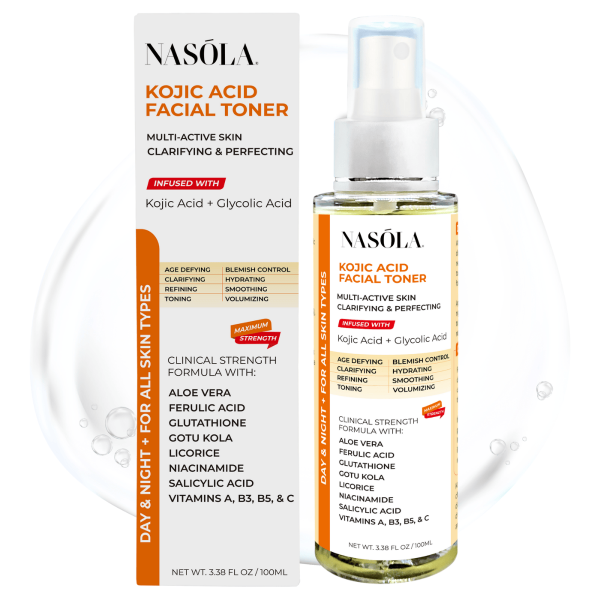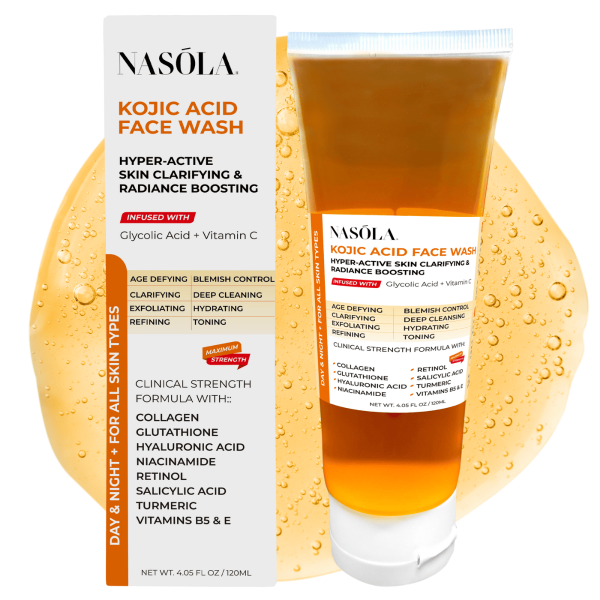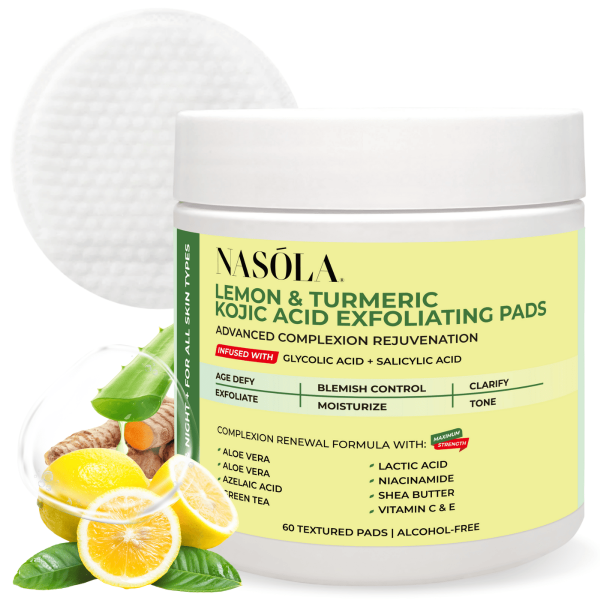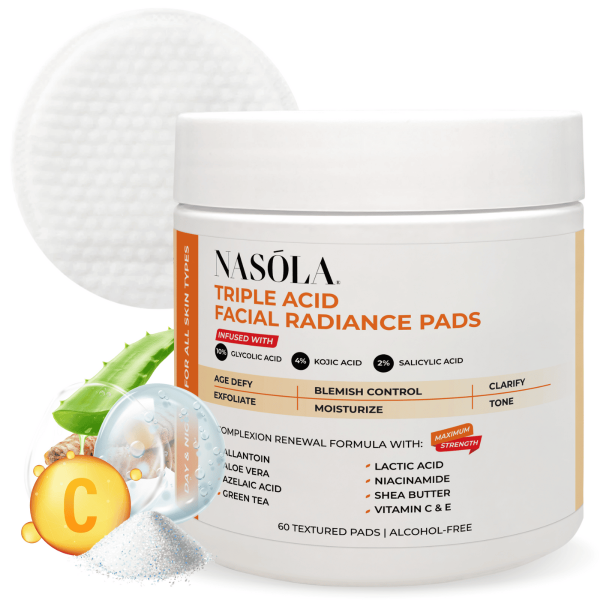Dark spots—ugh. Whether they’re whispers of teenage acne battles, souvenirs from sunny vacations, or those frustrating little hints of aging… they have a way of settling in uninvited.
And here’s the truth: when makeup starts to feel like armor, and Instagram filters are the only fix you trust, it’s time for a better solution.
That’s exactly why more and more people are turning to glycolic acid for dark spots. It’s not just popular—it’s proven.
This powerful alpha hydroxy acid (AHA) exfoliates away damaged surface cells, encourages new ones to emerge, and helps fade pigmentation with incredible reliability.
When paired with strategic products like the Nasola Kojic Acid Facial Toner, Nasola Kojic Acid Face Wash, and those magic-saturated Nasola Triple Acid Facial Radiance Pads? Yeah… dark spots don’t stand a chance.
So let’s really talk. What makes glycolic acid so effective—and how can you use it without messing up your skin? Buckle up, because you’re about to find out…
- Is Glycolic Acid Good for Dark Spots?
- Best Products Featuring Glycolic Acid for Dark Spots
- How to Incorporate Glycolic Acid in Your Skincare Routine for Dark Spots
- How Kojic Acid Enhances Glycolic Acid for Dark Spots
- Glycolic Acid for Dark Spots: Ingredient Focus – Turmeric
- Common Mistakes When Using Glycolic Acid for Dark Spots
- When to Expect Results from Glycolic Acid for Dark Spots
- Conclusion
- Frequently Asked Questions
Is Glycolic Acid Good for Dark Spots?
Few ingredients have as much glowing support behind them as glycolic acid when it comes to brightening frustrated, uneven complexion.
If you’ve been Googling “is glycolic acid good for dark spots,” take this as your sign. Yes—yes it is. But it’s not a magic wand. It’s more like a fast-track exfoliating ticket that your skin’s going to love (if used the right way).
How Glycolic Acid Works on Pigmentation
This AHA sinks deep. Glycolic acid breaks down the bonds that keep those stubborn, dead skin cells glued to your face. You know—those dull, blotchy layers that kinda hide your glow underneath?
Once those tired cells are out, new cells show up to the party. Fresh. Smoother. Less pigmented. And way more even-toned.
Benefits of glycolic acid for dark spots:
- Exfoliates surface layers of pigmented skin
- Stimulates faster skin regeneration
- Brightens complexion through reduced discoloration
- Boosts absorption of other spot-fading actives like kojic acid
But heads up—don’t overdo it. Glycolic acid is strong. Daily use without hydration or SPF? Recipe for irritation.
Clinical Support and Expert Recommendations
According to several dermatological studies, glycolic acid consistently reduces melanin-induced pigmentation. One peer-reviewed study in the Journal of Cosmetic Dermatology found that 8–10% glycolic acid significantly improved melasma and post-acne dark spots in just 4 weeks.
That’s not anecdotal—that’s science.
For a balanced alternative that’s safe and potent? The Nasola Triple Acid Facial Radiance Pads are a go-to.
They’ve got glycolic acid, salicylic acid, and lactic acid—an all-star exfoliating trio designed for uneven tone and stubborn hyperpigmentation.
Use them 2–3 times a week (max, especially if you’re new), and pair with a calming moisturizer.
Best Products Featuring Glycolic Acid for Dark Spots

When your routine needs a serious refresh—without spending hours layering too many serums—glycolic acid pads emerge as the top-shelf multitaskers.
They pack power, yet give you control. And if you’ve been wondering where to start?
This section is going to speak your language.
Glycolic Acid Pad Solutions for Daily Use
Pads offer pre-measured exfoliation. A swipe a day keeps the pigment at bay—if the formula respects your skin.
What makes a glycolic acid pad ideal:
- Consistent concentration (usually 5%–10%) to avoid overexposure
- Additional brighteners like kojic acid, turmeric, or vitamin C
- Easy, mess-free application
- Lightweight formulations that absorb quickly
The winner here? We love the Nasola Lemon Turmeric Kojic Acid Exfoliating Pads. Each pad is infused with:
- Glycolic acid for smoothness
- Kojic acid for melanin suppression
- Lemon extract for a touch of vitamin C
- Turmeric for calming redness and adding glow
Seriously—it’s skincare efficiency at its best. Perfect for morning or night, especially when you’ve got a dozen things to do before bed.
Targeted Blends for Deep Hyperpigmentation
If your dark spots have been around since your last vacation—two years ago—you need more than a surface swipe.
Use blends that go deeper, like:
- AHAs + BHAs for unclogging and clearing
- Kojic acid + glycolic acid combos
- Time-released pads that reduce irritation over time
- Antioxidants paired with exfoliants to protect new skin
The Nasola Triple Acid Facial Radiance Pads fulfill every single point. This triple-threat formula makes it easy to spot-treat old acne marks, post-inflammatory pigmentation, and even mild melasma with lasting clarity.
How to Incorporate Glycolic Acid in Your Skincare Routine for Dark Spots
You’ve got the products. The motivation. Now you just need to plug glycolic acid into your routine without making things worse.
The key? Start slow. Learn your skin. Build up once it asks for more.
Understand Proper Usage and Layering
Timing is EVERYTHING. Use glycolic acid in the evening only—it makes your skin temporarily more sensitive to the sun.
Here’s how a simple routine should flow:
- Gentle cleanse
- Toner (either hydrating or clarifying)
- Glycolic acid product
- Moisturizer
- Optional facial oil if your skin feels dry
Avoid using glycolic acid with:
- Retinoids or tretinoin on the same night
- Vitamin C — too much acidity
- Direct physical exfoliants like scrubs
- Fragrance-heavy products right after
Gentle Pre-Cleansing Recommendations
Don’t underestimate the power of a good cleanse. Harsh soaps dry you out. Oil-heavy cleansers leave residue. You need balance.
The Nasola Kojic Acid Face Wash brings a mild clarifying vibe that’s perfect before your chemical exfoliant. It’s sulfate-free, packed with kojic acid, and built to clean without wrecking your moisture barrier.
It dissolves makeup, sweat, and general gunk—so your glycolic acid can do its job. And it sets the stage for other products to actually penetrate (instead of sitting on dead skin).
How Kojic Acid Enhances Glycolic Acid for Dark Spots

If glycolic acid is the power tool, kojic acid is the sharp precision blade. Both target discoloration—but in complementary ways. Together? They work like warm and cool tones in the same outfit. Balanced and effortless.
Synergistic Effects of Kojic Acid + Glycolic Acid
While glycolic acid breaks down the top layers of dead, pigmented skin… kojic acid swoops in to halt melanin production. That’s what prevents future dark spots from forming.
Why this combo matters:
- Kojic acid fades stubborn pigmentation at the source
- Glycolic acid reveals healthier skin faster
- Reduced need for harsh bleaches or hydroquinone
- More even-toned glow over time
The Nasola Lemon Turmeric Kojic Acid Exfoliating Pads are brilliant at bringing these benefits together into a single step.
Toners to Maximize Penetration
After cleansing, your skin’s pH shifts. That shift can block absorption of actives—or make them sting.
A gentle toner helps:
- Balance skin’s natural acidity
- Calm irritation
- Hydrate without greasiness
- Improve absorption for exfoliants
The Nasola Kojic Acid Facial Toner is crafted exactly for this. It combines kojic acid, rose water, and witch hazel—ideal for rebalancing, and supporting glycolic acid’s glow-boosting power.
Bonus? It smells lovely. Think fresh garden meets skin refresh.
Glycolic Acid for Dark Spots: Ingredient Focus – Turmeric
Turmeric in skincare isn’t hype. It’s hundreds—yes, hundreds—of years old. And when paired with glycolic acid, it makes your results less irritating and way more calming.
Why Turmeric Matters in Brightening Skincare
Turmeric steps in when inflammation tries to ruin your good skin plans. It reduces redness, neutralizes bacteria, and slows down oxidative stress (which causes spots to darken).
Here’s what turmeric does:
- Reduces overactive melanin response
- Balances skin tone naturally
- Contains curcumin—an anti-inflammatory powerhouse
- Soothes skin post-peel or exfoliation
Products that add turmeric to glycolic acid formulas almost always feel kinder. Gentler. Less aggressive. And they’re good for nearly ALL skin types.
Effective Pairing with Glycolic Acid
One of our favorites, again, is the Nasola Lemon Turmeric Kojic Acid Exfoliating Pads. They bundle turmeric, glycolic acid, and kojic acid into one exfoliating pad that:
- Brightens
- Evens skin tone
- Gently clears clogged pores
- Calms skin with turmeric’s built-in anti-inflammatory magic
That’s like having a serum, toner, and exfoliant in one single pad. Convenience meets glow-up.
Common Mistakes When Using Glycolic Acid for Dark Spots
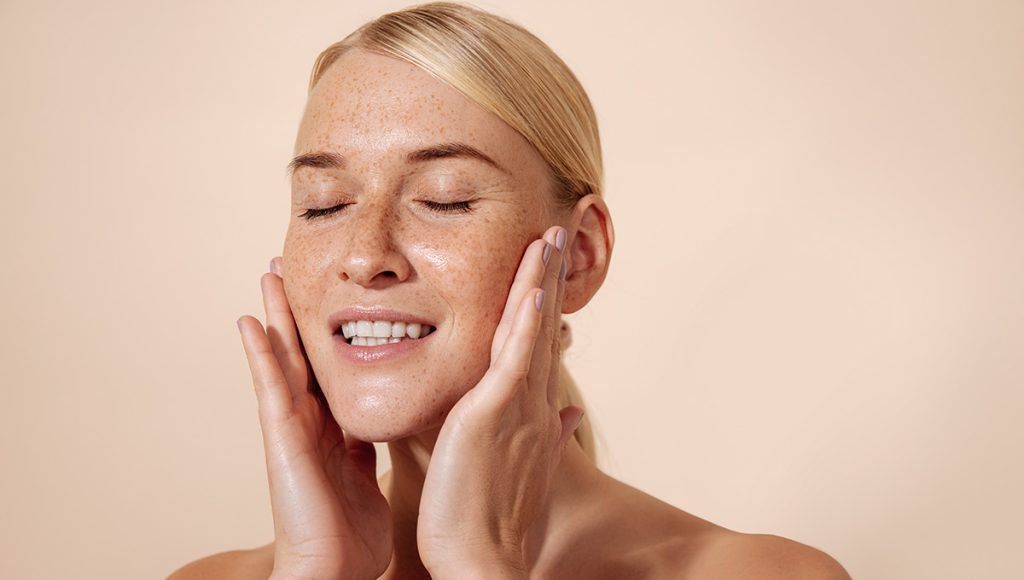
With great power comes great skin responsibility.
Overdoing your glycolic acid steps can backfire HARD. Think sensitivities, peeling, redness—and even worsening of pigmentation.
Here’s how to avoid those common traps.
Over-exfoliation and Sensitivity Issues
Anyone can fall into the trap of thinking more acid equals more glow. But nope. Your skin barrier needs space to breathe and heal.
Glycolic acid shouldn’t be:
- Used more than 3x/week unless your skin is conditioned
- Layered with harsh exfoliants or scrubs
- Applied without SPF during daytime
- Left on visibly irritated skin
Peeling or tingling may be normal; burning and flaking aren’t. Know the line.
Not Moisturizing or Using Soothing Agents
Post-acid care determines the results. After exfoliation, your skin’s more vulnerable—but way more eager to absorb the goodness.
Must-haves post glycolic acid:
- Lightweight, fragrance-free moisturizer
- Barrier-protecting agents like ceramides or hyaluronic acid
- Aloe vera to cool things down
- Omega-rich oils (grape seed, marula) if your skin is drier
Comforted skin = beautiful skin.
When to Expect Results from Glycolic Acid for Dark Spots
Let’s be honest: we all love fast wins. But fading dark spots is a journey, not a pit stop.
So… when will you REALLY see results with glycolic acid?
Timeline Expectations for Glycolic Acid Benefits
Based on skin type and concentration:
- 1–2 weeks: Improved texture, soft glow
- 3–4 weeks: Fading of mild pigmentation or acne marks
- 5–8 weeks: Noticeable difference in uneven tone, fine lines
- 8+ weeks: Deep discoloration (like melasma) starts to lift
Patience, sunscreen, and consistent use = your transformation power trio.
Supporting Products that Accelerate Results
Add boosters to help glycolic acid perform better.
Try these:
- Nasola Kojic Acid Face Wash for gentle prepping
- Nasola Kojic Acid Facial Toner for pH rebalancing
- Nasola Triple Acid Facial Radiance Pads for a stronger blend
- Nasola Lemon Turmeric Kojic Acid Exfoliating Pads for calmer lightening
These aren’t just good—they’re proven, plant-powered, and work with your skin.
Conclusion
If hyperpigmentation has been messing with your confidence, you’re not stuck with it. You’re simply one good product—and one consistent routine—away from change.
Using glycolic acid for dark spots isn’t a trend. It’s a trusted method to exfoliate away discoloration, brighten your complexion, and uncover that smoother skin you KNOW is in there.
When you team glycolic acid with powerhouses like kojic acid and turmeric, through high-performance products like the Nasola Kojic Acid Facial Toner, Nasola Kojic Acid Face Wash, Nasola Triple Acid Facial Radiance Pads, and Nasola Lemon Turmeric Kojic Acid Exfoliating Pads?
You set your skin up to thrive. Now go glow with intention ✨
Frequently Asked Questions
Yes, glycolic acid is excellent for treating dark spots. It works by exfoliating the top layers of dead, pigmented skin, allowing new, clearer skin to emerge. Over time, this reduces the visibility of dark marks and creates a more even complexion.
Most users notice improvement within 4–6 weeks of regular use. Products like the Nasola Triple Acid Facial Radiance Pads combine glycolic, salicylic, and lactic acid to speed up cellular turnover and show quicker brightening results.
Yes. Glycolic acid exfoliates the skin, allowing kojic acid to penetrate more effectively and inhibit melanin production. The combo in products like Nasola Lemon Turmeric Kojic Acid Exfoliating Pads delivers significant improvements in pigmentation with less irritation.
For beginners with sensitive skin, products like Nasola Lemon Turmeric Kojic Acid Exfoliating Pads offer a gentle alternative, combining turmeric and kojic acid with a moderate glycolic acid concentration to minimize irritation.
Absolutely. Glycolic acid increases your skin’s sun sensitivity. If you skip sunscreen, dark spots can worsen. Always apply SPF 30 or higher SPF when using glycolic acid-based products—no exceptions.
Overuse can lead to dryness, burning, peeling, redness, and worse pigmentation. Stick to 2–3 times per week while gradually increasing frequency based on your skin’s tolerance.
Only at night. During the day, it can make your skin photosensitive. Always follow with gentle products and never combine it with retinol or other strong acids in the same routine.
Yes. Glycolic acid not only fades pigmentation but also smooths skin texture linked to acne scarring. Use it consistently with gentle cleansers like the Nasola Kojic Acid Face Wash to prep the skin daily.
If you’re new, start with 2–3 times per week and see how your skin reacts. Some advanced users tolerate daily use, but it’s always best to listen to your skin.
Ingredients like turmeric and kojic acid are powerful natural options that work beautifully when paired with glycolic acid. Products like the Nasola Kojic Acid Facial Toner harness this synergy for safer brightening.


